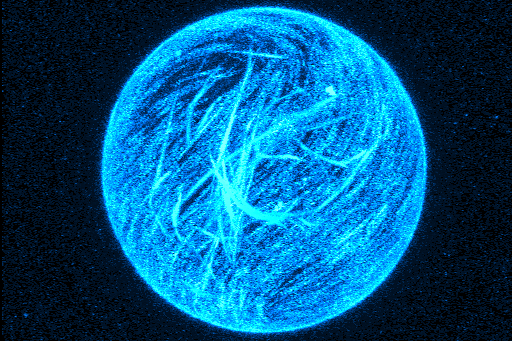Brandeis physicists unlock secrets of the 2-D world and edge closer to artificial cells
The Dogic Lab featured in Nature and Science
 Photo/Keber, Loiseau, Sanchez, Bausch/TUM
Photo/Keber, Loiseau, Sanchez, Bausch/TUM This synthetic cell-like sac, created by the Dogic lab, has bio-molecules that form a layer on the membrane that actively drives continuous motion.
Physicist Zvonimir Dogic and his lab are on a roll. Last week, Dogic’s research was featured in two of science’s most respected journals, Science and Nature.
Science featured the Dogic team’s innovative research on its cover. The lab engineered a Frankenstein-like, microscopic synthetic sac, stitched together from different kinds of biomolecules, that can move and change shape on its own. It’s an active nematic vesicle and it could be the first step toward building artificial cells.
This research, part of Brandeis’ Materials Research Science and Engineering Center (MRSEC), and included graduate students Tim Sanchez and Stephen DeCamp. The Brandeis team collaborated with scientists from Technical University of Munich (TU Munich), Leiden University in the Netherlands, and Syracuse University.
The day before Science came out, Dogic and physics professor Michael Hagan also published a different study in the journal Nature. Postdoctoral fellow Prerna Sharma and graduate student Andrew Ward coauthored that paper, also funded by MRSEC.
The Nature paper explored the world of two-dimensional physics. In the three-dimensional world, oil and water separate when combined. The smaller droplets of oil merge with larger ones, eventually forming one continuous layer that floats on water.
But in the 2-D world, things work very differently. Take our cell membranes, a two-dimensional liquid world. Liquid lipid “rafts” float on the surface of membranes, carrying proteins and regulating transport in and out of the cell.
If the lipid rafts behaved like liquid in the 3-D world, the individual rafts would coalesce into one larger raft. But as the researchers observed, the 2-D world has its own operating system.
To get an inside peek at this microscopic world, Dogic and Hagan needed to scale up significantly. They used long rod-like viruses to create a colloidal membrane — a membrane made up of thousands of smaller particles — like our cell membranes but much, much larger. To build the lipid rafts, they used shorter rod-like viruses.
When the team put the shorter and longer viruses together, something unexpected happened: Instead of separating like oil and water, the short rods self-assembled into smaller droplets of equal size and shape. And they held that size and shape. Even when the sample started out with different sized droplets, they all equalized. Even when the team split a droplet, it returned to its original size a few hours later.
The team discovered droplets don’t coalesce because they actively repel each other, like magnets flipped on one side. A droplet’s chirality — the way its component rods twist in space — creates a distortion in the membrane, which its fellow droplets want to avoid.
So what does this all mean?
It means we’re just beginning to lift the curtain on the two-dimensional world — and we can expect many more big weeks for Brandeis’ MRSEC scientists.
To learn more about Hagan and Dogic's research and see videos of the membranes and rafts, visit The Office of Communication's science and research Blog, ReAction.
Categories: Research, Science and Technology





